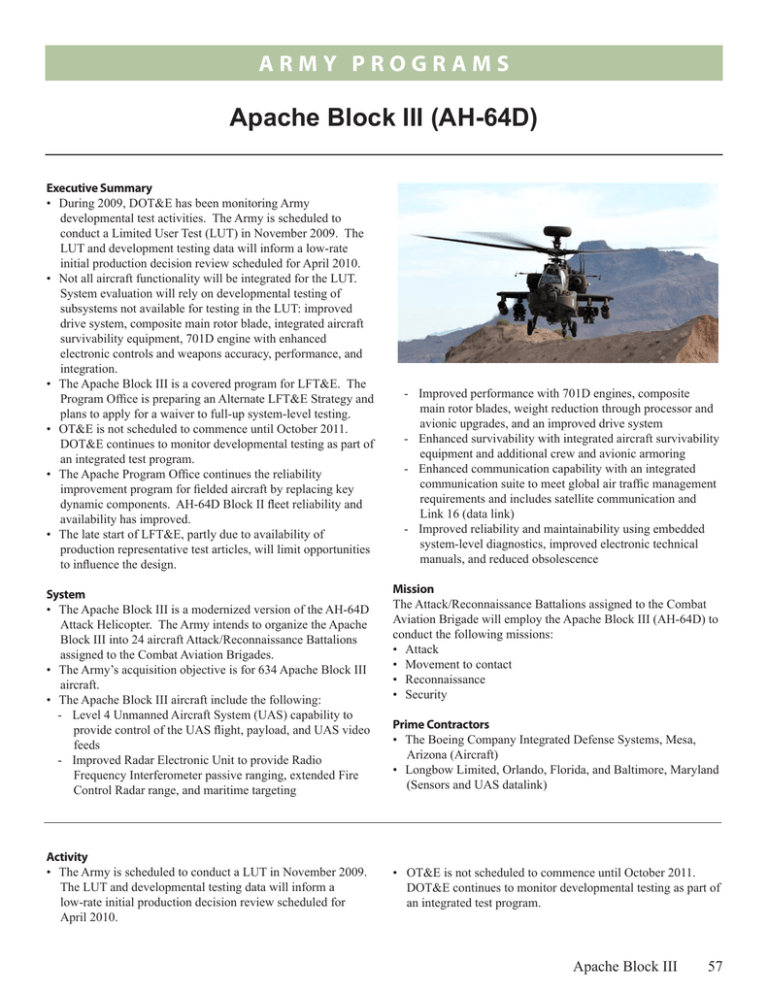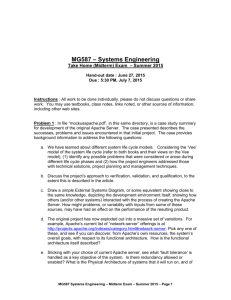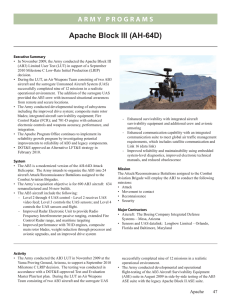Apache Block III (AH-64D)
advertisement

AR M Y P ROGRA M S Apache Block III (AH-64D) Executive Summary • During 2009, DOT&E has been monitoring Army developmental test activities. The Army is scheduled to conduct a Limited User Test (LUT) in November 2009. The LUT and development testing data will inform a low-rate initial production decision review scheduled for April 2010. • Not all aircraft functionality will be integrated for the LUT. System evaluation will rely on developmental testing of subsystems not available for testing in the LUT: improved drive system, composite main rotor blade, integrated aircraft survivability equipment, 701D engine with enhanced electronic controls and weapons accuracy, performance, and integration. • The Apache Block III is a covered program for LFT&E. The Program Office is preparing an Alternate LFT&E Strategy and plans to apply for a waiver to full-up system-level testing. • OT&E is not scheduled to commence until October 2011. DOT&E continues to monitor developmental testing as part of an integrated test program. • The Apache Program Office continues the reliability improvement program for fielded aircraft by replacing key dynamic components. AH-64D Block II fleet reliability and availability has improved. • The late start of LFT&E, partly due to availability of production representative test articles, will limit opportunities to influence the design. System • The Apache Block III is a modernized version of the AH-64D Attack Helicopter. The Army intends to organize the Apache Block III into 24 aircraft Attack/Reconnaissance Battalions assigned to the Combat Aviation Brigades. • The Army’s acquisition objective is for 634 Apache Block III aircraft. • The Apache Block III aircraft include the following: - Level 4 Unmanned Aircraft System (UAS) capability to provide control of the UAS flight, payload, and UAS video feeds - Improved Radar Electronic Unit to provide Radio Frequency Interferometer passive ranging, extended Fire Control Radar range, and maritime targeting Activity • The Army is scheduled to conduct a LUT in November 2009. The LUT and developmental testing data will inform a low-rate initial production decision review scheduled for April 2010. - Improved performance with 701D engines, composite main rotor blades, weight reduction through processor and avionic upgrades, and an improved drive system - Enhanced survivability with integrated aircraft survivability equipment and additional crew and avionic armoring - Enhanced communication capability with an integrated communication suite to meet global air traffic management requirements and includes satellite communication and Link 16 (data link) - Improved reliability and maintainability using embedded system-level diagnostics, improved electronic technical manuals, and reduced obsolescence Mission The Attack/Reconnaissance Battalions assigned to the Combat Aviation Brigade will employ the Apache Block III (AH-64D) to conduct the following missions: • Attack • Movement to contact • Reconnaissance • Security Prime Contractors • The Boeing Company Integrated Defense Systems, Mesa, Arizona (Aircraft) • Longbow Limited, Orlando, Florida, and Baltimore, Maryland (Sensors and UAS datalink) • OT&E is not scheduled to commence until October 2011. DOT&E continues to monitor developmental testing as part of an integrated test program. Apache Block III 57 A r m y P ROGRA M S • Avionics flight testing continues on two aircraft to demonstrate functionality of Level 4 UAS control, Radar Electronic Unit, and Integrated Helmet and Display Sight System capabilities. • The Army is testing the improved drive system. They began endurance testing on a test stand and will complete 200 hours of integration testing on the ground test vehicle. • The Composite Main Rotor Blade has completed qualification for flight testing and continues fatigue testing in a structural test lab. • The Army completed developmental and customer testing of the integrated aircraft survivability equipment in an Apache Block II aircraft. • The Apache Program Office continues the reliability improvement program for fielded aircraft by replacing key dynamic components. Key components include main transmission, main rotor head, tail rotor gearbox, tail rotor swashplate, engine nose gearbox, main rotor swashplate, actuators, pumps, and servos. • The LFT&E Integrated Product Team has met on several occasions to discuss tasks, assets, and schedules for the Alternate LFT&E Strategy to support a request for a waiver from full-up system-level testing. Live Fire testing is scheduled to start 1QFY11 and be complete by 4QFY11 to support a full-rate production decision in 3QFY12. Assessment • Avionics aircraft have demonstrated the capability to exercise Level 2-4 control of surrogate UAS in developmental flight testing. 58 Apache Block III • The Radar Electronic Unit generates false targets in some operating modes, but generally performs as well as legacy radar avionics. • Early Integrated Helmet and Display Sight System testing has identified problems with cockpit registration, site picture stability, and operator comfort. • Structural weakness around fastener holes in the top cover of the new transmission has resulted in oil leakage and a redesign of the cover, adding strength and weight to the transmission. • The integrated aircraft survivability suite improves pilot understanding of threat locations and provides new capability to locate and target threat systems. • AH-64D Block II fleet reliability and availability has improved. • The late start of LFT&E, partly due to availability of production representative test articles, will limit opportunities to influence the design. Recommendations • Status of Previous Recommendations. There was no annual report for Apache Block III in 2008. • FY09 Recommendations. The program should: 1. Develop and implement reliability improvements on baseline and Apache Block III components. 2. Look for opportunities for test articles to support earlier Live Fire test events.




